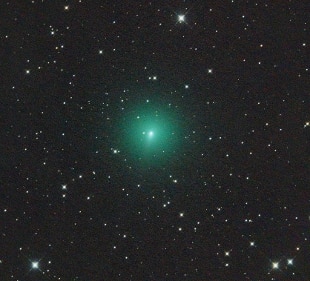Share
by Andrea Bettini March 28, 2020 It was discovered a few months ago and is already a candidate to become the protagonist of 2020 from an astronomical point of view. Comet C / 2019 Y4, for simplicity renamed comet Atlas, is approaching. In all likelihood it will become visible to the naked eye, even from Italy.A few more weeks of waiting
Currently the comet Atlas is located over 150 million kilometers from Earth and about 240 million kilometers from the Sun. However, its distance is reduced every day and its brightness increases rapidly. “With a reasonable margin of certainty we can say that it should become visible to the naked eye between the end of April and the beginning of May - says Albino Carbognani, researcher of the INAF Observatory of Astrophysics and Space Science in Bologna - It will be observable at very convenient times, a couple of hours after sunset. We will have to look north-west, about 30 or 40 degrees above the horizon, first in the constellation of the Giraffe and then in the constellation of Perseus. It will be visible to the naked eye until around May 20. On May 31 it will reach perihelion, the point closest to the Sun, but in those days it will be too close to our star to be observed ".
A green wad
To see it better it will be important to stay as far away from street lamps and other light sources as possible and maybe use binoculars. Meanwhile, astrophotography enthusiasts, using telescopes, have already started taking the first shots. The comet in the images looks like a pretty green wad. "The ice on its surface is sublimating as it approaches the Sun - explains Albino Carbognani - There is a lot of green and little yellow in its crown: this means that it is composed largely of gas and not dust".
"Sister" of the Great Comet of 1844?
In addition to studying its composition, astronomers have carefully analyzed its orbit, which is very elliptical and goes beyond that of Pluto. The comet Atlas travels it in about 6000 years and is very similar to that of the Big Comet of 1844, which gave a show almost two centuries ago. Perhaps there is a link between the two. "It is reasonable to think that they are two fragments of the same original nucleus: a progenitor comet that broke about 6000 years ago passing near the Sun - continues Albino Carbognani - It is a very fascinating hypothesis that will be verified in the coming months".
A time machine
For astronomers this is an opportunity to collect valuable data. “Comets are interesting because they are very primitive bodies - explains Albino Carbognani - By analyzing the gases, we obtain information on the chemical composition of the Solar System as it was billions of years ago, at the time of the formation of the planets. Studying them is a bit like taking the time machine. "

